
Architectural Styles and Revivals: The Colonial Revival
(written by Dr. Les Crocker, UWL Emeritus Professor of Art History)
The Panic of 1873 was a financial crisis that triggered an economic depression in Europe and North America that lasted from 1873 to 1879 in some regions. When everyone is depressed there's nothing like a party to improve morale.
So, to celebrate the centennial, political leaders and businessmen created the United States Centennial International Exhibition. It was held from 10 May to 10 November, 1876 in Philadelphia; the birthplace of the Declaration of Independence.
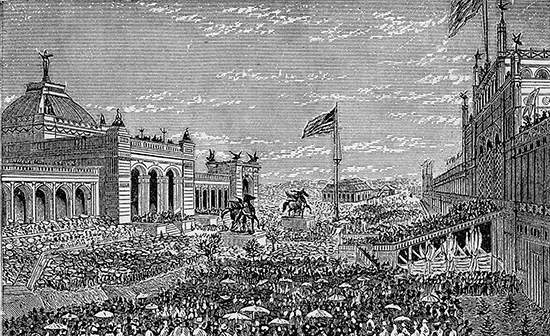
An engraving depicting the opening of the Centennial Exhibition in May 1876.
Great exhibitions were not new. The Exhibition of 1851 in London had amazed the world with its mass-produced cast-iron frame and gigantic expanses of glass. Ten million people had a shared experience. Telephones, typewriters, and sewing machines were very popular. Since that time, other cities had similar, but smaller, exhibitions of national manufacturing, agricultural goods, art works, etc. from nations around the world as a major entertainment and economic booster.
The old argument that the United States needed an “American” architecture was resurrected, but what at first seemed clear-cut and definable, soon changed into another catch-all style. By 1876, the various revival styles and the pseudo-revivals were well-known and documented, but relatively little was known about house types before the revolution. Somehow, newspaper editors, magazine publishers and other public influencers decided that these pre-revolution buildings were the "true" American buildings and they should be emulated. The excavation and restoration of Colonial Williamsburg is part of the search for our early roots.
The problem was: what colony and when? The thirteen colonies were all English colonies, but soon the presence of Dutch Colonial, Spanish Colonial and even French Colonial were acknowledged and imitated. New England mostly built in frame: heavy posts and beams with infill of soft brick; or the wattle and daub material of the common people. Virginia was rich in clay and preferred brick, considered a more elegant material than wood. The Carolina seacoast had its own vernacular style, still seen today in Charleston, SC.
In La Crosse, there was little interest in the Colonial Revival in the last quarter of the nineteenth century (Queen Anne was still predominant), but you start to see this style appearing in the early twentieth century and continue well into mid-century.
English Colonial
The James and Rosemary Trane House, 435 N. 24th St., 1940
The James and Rosemary Trane house is a curious revival of Massachusetts houses from the 1600s, like the Boardman House in Saugus. The Boardman house used heavy timbers for supporting posts and beams. Some carpenters preferred a second story overhang of about a foot, probably to reduce the number of joints in the same place. Another theory is that it provided a sort of porch roof for pedestrians. That might be true in urban locations, but many of these houses were rural farmhouses and there wasn't any foot traffic across the front of the house that needed to be sheltered.
The second-story front corner posts often extended below the cross beam and were carved into balls or some other decorative shape. They have no structural function that I am aware of.
The gables above the second-story windows suggest roof dormers, but dormers were not used in the 1600s in Massachusetts.

The Trane house. Notice the decorative carved spheres under the overhang; they appear where structural posts would have been in the 1600s version. 2010 photo by author.
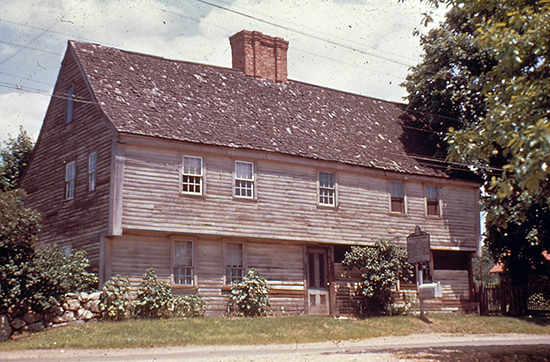
The Boardman house in Saugus, MA features the second-story overhang and central fireplace that are typical of “Colonial” style and show up in revival homes. Contrary to popular belief, there weren't trap doors in the overhang so the settlers could defend against attackers. That myth must have come from some deranged tour guide.
I had never seen the revival of a 1600s Massachusetts timber frame house with overhang before. To make it even more curious if you walk up the street to 505 N. 24th and 511 N. 24th you will see two other variations on the same design.
400 S. 15th St., 1939-40
Ethel Tausche, probably the only female contractor/architect in La Crosse, designed this three-bay Colonial revival in 1939-40. A lovely broken pediment with an interior urn is supported by fluted Roman Doric pilasters.

This home is a great example of a scaled-back Colonial Revival home. 2010 photo by author.
In La Crosse, the Colonial Revival seems to be the style of the middle-class, from lower- to upper- with some appearance in upper-class houses. Several types of supposedly colonial house types became almost generic. The two-story, five-bay, center entrance type is very common with some outstanding examples.
The Bentley-Merman partnership is best known for their Prairie style houses, but after he left La Crosse Bentley designed many Colonial Revival houses in the northwest.
The Scott House, 1721 King St., 1918
The Scott house shows the Bentley-Merman attention to detail, as well as their reliance on original examples. Five bays wide with the long side to the street, central entrance with open pediment, slim classical columns and side lights flanking the doorway and pilasters to support the entablature that defines the entrance. The windows are six panes over six panes. The window heads are minimal, just enough to turn the rain.
Central chimneys were more common in the 1600s in New England and chimneys on the ends of the house in the 1700s. They could be exterior end chimneys or interior end chimneys, both types were used.
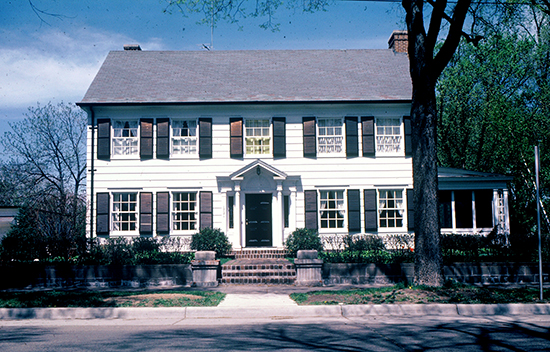
The Scott house revival features include the end chimneys typical of the 1700s. 1978 photo by author.
After Bentley left town, Otto Merman continued to design Colonial Revival houses with as much grace and elegance as when Bentley had been his partner.
Henry Gund House, 1509 King St., 1905-06
The grandest of the English Colonial Revival houses was that of Henry Gund. It probably had the largest square footage of any house ever built in La Crosse. It was huge, as can be seen in the photographs. According to the Argus newspaper on December 30, 1905 the house had already cost $40,000 and the total would be “far in excess” by the time it was finished.

The Henry Gund house was sold to the English Lutheran Church in 1952 and was the site of Luther House, a venue for the church’s Sunday school classes and other gatherings. In 1961, the home was razed to build a new church structure that would unite three separate church facilities.
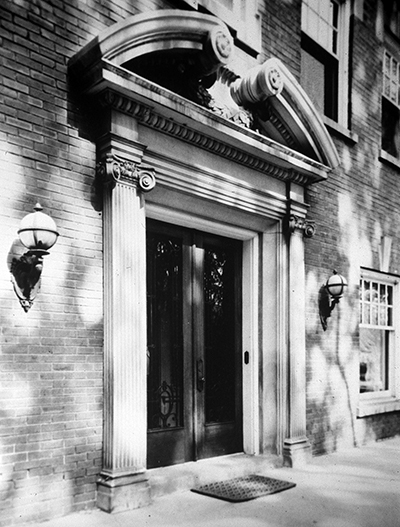
The attention to detail is evident in the grand double-door entrance. The home had four fireplaces, eight bedrooms and even an elevator!
Cape Cod Cottages
The other supposed colonial house type was the Cape Cod cottage, which had little to do with Cape Cod and a lot to do with the marketing of houses. They were rectangular in plan, with the long side facing the street, a story and a half high, gable roof, often with dormers, a center entrance and usually, three or five bays wide.

This cottage at 1322 Main has a three-bay front, a story and a half high, with two gable roof dormers. Cottages don't usually have entrance porches. 2015 photo by author.
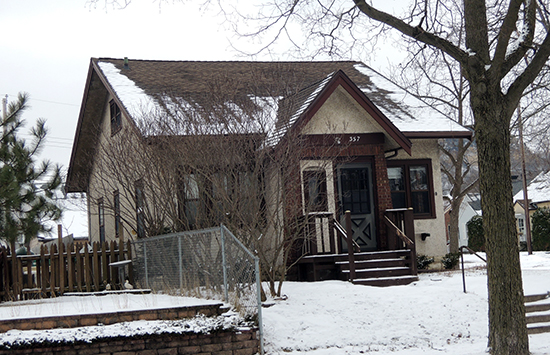
The Earl & Fern Krause house at 357 S 23rd built in 1929 to the design of Ethel Tausche. This is an unusual design with a cement exterior and a brick entry. 2015 photo by author.
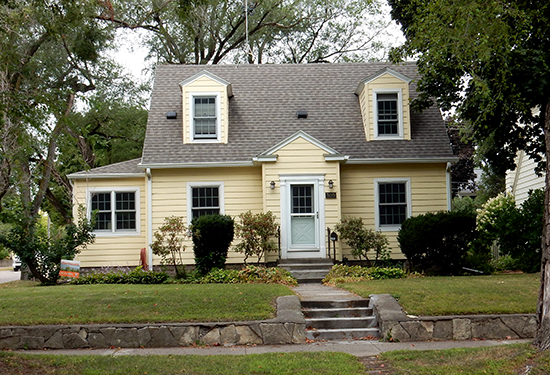
At 303 N. 24th St., the Wilkinson house from 1935 shows the standard cottage pattern of three bay front two, dormers matching the windows below, but with a non-typical entrance extended from the house with gable roof with cornice returns suggesting a classical pediment. 2023 photo by author.

The Fred Silbersmith house at 310 N 23rd from 1938 is a delightful building but stretches the definition of a cottage. In an original cottage the wings on each side of the main building would have been additions to expand the living space. Cottages seldom had entrance porches. 2023 photo by author.
Spanish Colonial
The Spanish Colonial Revival appeared in the early twentieth century. I have often commented on how before the twentieth century architecture was very affected by the geography, climate and available building materials. Spanish architecture in the U.S. was always limited to a small part of what is now Florida and the far south-western states. The style was characterized by a flat roof, adobe walls, sunbaked mud brick covered with a plaster; all suitable in very dry climates, but not wet, snowy climates.
Guy and Eloda Beach House, 205 Losey Blvd. N., 1926
The Guy and Eloda Beach House was designed by Carl Schubert, who is also remembered for the dormitories he created for the University of Wisconsin-La Crosse. White cement stucco covers the walls, while red ceramic tiles on the roof crenellations provide a contrasting color. The ground plan is rectangular with a rear addition in keeping with the idea of a simple house. A small semi-circular porch protects the entrance and there is a semi-circular bay window on the south side. Semi-circular bays are not common, but I think Schubert wanted to emphasize the fluidity of the adobe format as opposed to the standard bay window defined by the dimension lumber used in most houses.
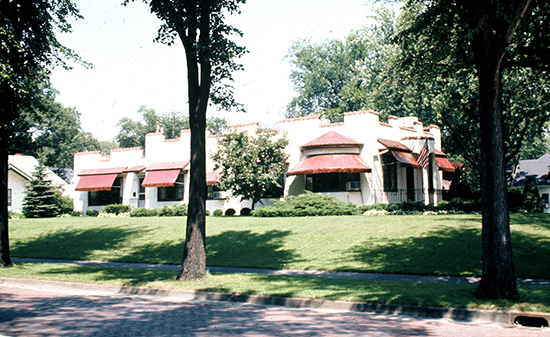
The semi-circular bay window is front and center in this view of the south side of the Beach home. Undated photo by author.
Art & Kate Schwalbe House, 204 S. 20th St., 1923
The house at 204 S. 20th was built for Art and Kate Schwalbe in 1923 in a very low-key Spanish style. The red ceramic roof tiles and stucco walls define the style, but the present owner says winter temperatures can cause problems when water gets into tiny cracks and freezes. Many adobe buildings had a stone arch at the entrance and the Schwalbe house also has that feature; it breaks the flatness and angles and therefore attracts the eye. The balcony above has a delightful railing that matches the stair railing at the entrance. The double doors would have provided nice ventilation but the balcony is mostly for stylistic purposes.

The design of the Schwalbe house references the Spanish style in the roof, the finish, and the arched door with balcony above. 2023 photo by author.
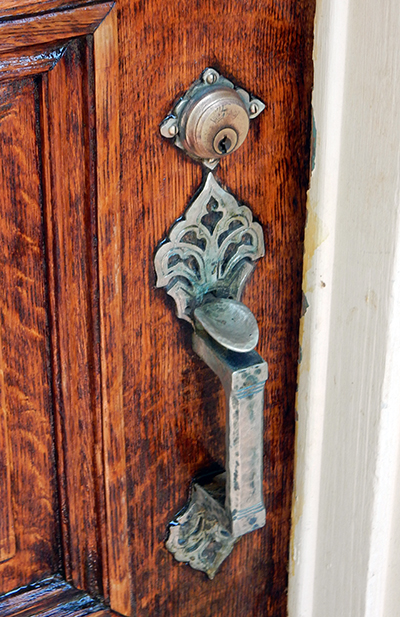
Small details can have a major impact. The front door latch. 2023 photo by author.
1415 State St., possibly ca. 1914
The small house at 1415 State St, possibly built in 1914, is covered in white cement stucco, considered a wonder material in the early twentieth century. The flat roof, not a good idea in our climate, is bordered by a wall with crenellations and red tiles.

If this house was built at this time, it would be the earliest example of the Spanish Revival style in La Crosse. 2011 photo by author.
Dutch Colonial
In the early 1600s, the Dutch had several colonies in the northeastern part of what became the United States. However, the disastrous religious wars of the middle 1600s and the need to unify the provinces of the European low country left little money to support any colonies and they came under English control. New Amsterdam, which became New York, is the most famous of the Dutch colonies.
Dutch Colonial Revival is mostly indicated by a gambrel roof, what many people call a barn roof.
Like the mansard roof, it was intended to give more head room in an attic to allow extra rooms in what is otherwise a not very useful space. There are no nineteenth century La Crosse houses fully in the Dutch Colonial style, but the gambrel roof became a distinctive element in some houses built in the 1920s, 30s, and 40s.
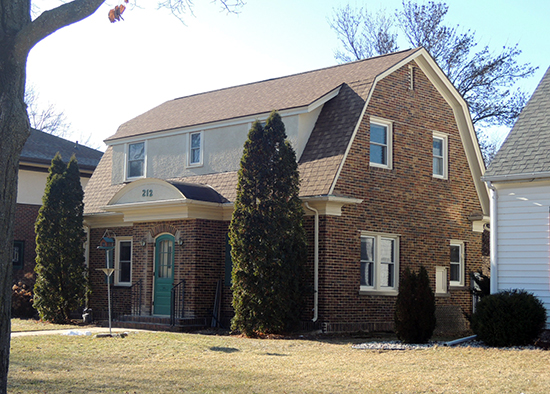
The Johnson house at 215 S. 21st St., built in 1940, shows the gambrel roof common in the style with a large front dormer and an extended entry with a rather unusual barrel vault roof. 2014 photo by author.
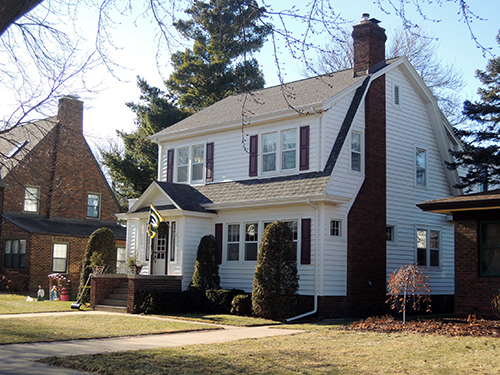
The Knothe house at 224 S. 21st St., built in 1924, is more typical of the style in the use of frame construction. 2010 photo by author.
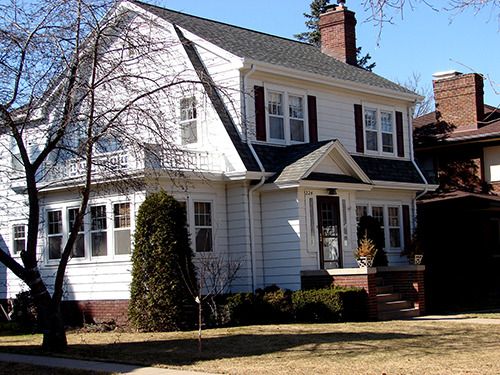
The sun porch was not usually part of the Dutch Colonial Revival, except in La Crosse where sun porches are added on every style imaginable. 2010 photo by author.
Pre-Civil War South Influences
The great columned mansions from the pre-Civil War South somehow got revived even though the idea had only been gone a few decades.
Fred Cutler House, 1601 Madison St., 1902
Fred Cutler’s house mixes Georgian with generalized neoclassicism. Two-story columns with Ionic capitals create a dramatic front, however, the flat roofed porch, dormer windows and hip roof were never used on this type of house in the South. A Georgian elaborated frame surrounds the entrance and three narrow windows above it further emphasizes the center.
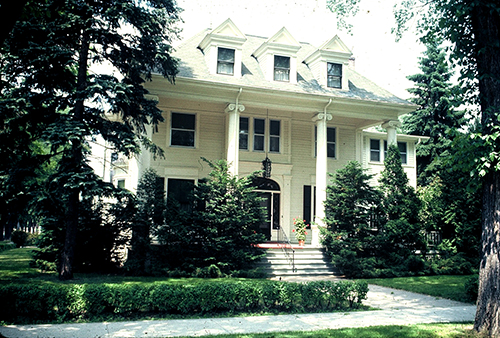
While the two-story porch is a neoclassical element, the gabled dormer windows and hipped roof are Colonial Revival elements. 1976 photo by author.
John Elliott House, 1420 King, 1936
The John Elliott house is a typical pre-Civil War design from Tennessee, or northern Mississippi and Alabama, but built in brick instead of wood. The great portico has two-story columns with Corinthian capitals. The entrance has a very simple surround, with a curved sided pediment above the entablature. Tall windows, six over nine panes, on the ground floor have limestone sills and window heads with a raised keystone.
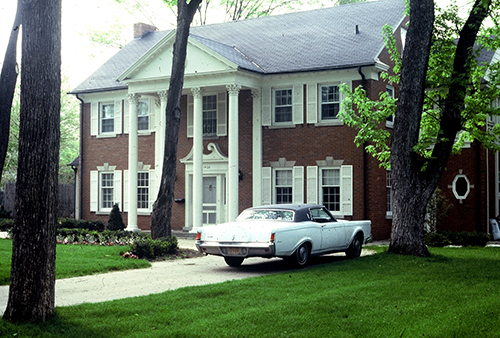
The form of the Elliot house is similar to English Colonial Revival, but it features neoclassical elements in portico and columns. 1978 photo by author.
Colonial Revival Elements
The Meason House, 208 S. 9th St.
The Meason house was a simple Italianate: three-bay front with secondary entrance, a double-leaf door with top light, and simplified pediments for window heads. Sometime in the early twentieth century, the simple Italianate porch was replaced with a Colonial Revival wraparound porch with Tuscan Doric columns. A few years ago, this porch was replaced with a simplified Italianate single bay porch similar to what was there originally. Unfortunately, the brick was painted years ago, so the contrast of the red with white limestone window heads and sills has been lost. The pediment shaped window heads on the ground floor are not original.
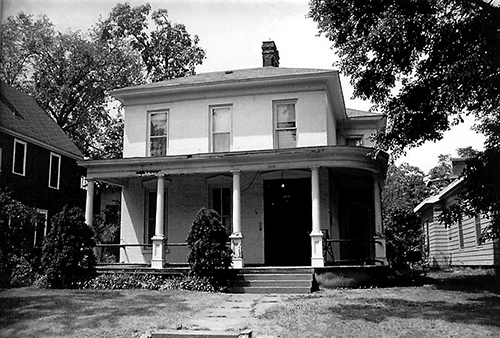
A photo of the Meason house with the Colonial Revival porch. 1980 photo by author.

With the replacement of the porch, the look of this home is closer to its original Italianate style. 2015 photo by author.
The Colonial Revival is perhaps the most used style in our history, but also the most indefinite. Fortunately, or not, the style had only a limited impact in La Crosse in the nineteenth century and that was mostly on large houses. In the twentieth century, the style continued and was very popular for middle class houses.
This series will wrap up in March with an in-depth look at the Romanesque Style, a style once very popular in La Crosse and one that would inadvertently start a preservation movement here.
Other entries in this series
Architectural Styles and Revivals
Architectural Styles and Revivals: The Greek and Roman Revivals
Architectural Styles and Revivals: The Gothic Revival
Architectural Styles and Revivals: The Exotic Revival
Architectural Styles and Revivals: The Italianate Style
Architectural Styles and Revivals: The Second Empire Style
Architectural Styles and Revivals: The Queen Anne Style
Architectural Styles and Revivals: Romanesque Revival Public Buildings
Architectural Styles and Revivals: Romanesque Revival Commercial Buildings
Architectural Styles and Revivals: Romanesque Revival Homes
Architectural Styles and Revivals: Religious Romanesque
